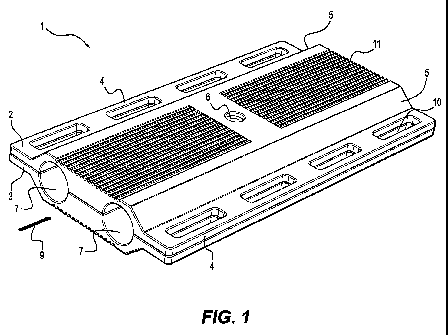Some of the information on this Web page has been provided by external sources. The Government of Canada is not responsible for the accuracy, reliability or currency of the information supplied by external sources. Users wishing to rely upon this information should consult directly with the source of the information. Content provided by external sources is not subject to official languages, privacy and accessibility requirements.
Any discrepancies in the text and image of the Claims and Abstract are due to differing posting times. Text of the Claims and Abstract are posted:
| (12) Patent Application: | (11) CA 2870928 |
|---|---|
| (54) English Title: | MARINE SURVIVAL POD |
| (54) French Title: | RADEAU DE SURVIE EN MER |
| Status: | Deemed Abandoned and Beyond the Period of Reinstatement - Pending Response to Notice of Disregarded Communication |
| (51) International Patent Classification (IPC): |
|
|---|---|
| (72) Inventors : |
|
| (73) Owners : |
|
| (71) Applicants : |
|
| (74) Agent: | BERESKIN & PARR LLP/S.E.N.C.R.L.,S.R.L. |
| (74) Associate agent: | |
| (45) Issued: | |
| (86) PCT Filing Date: | 2012-04-18 |
| (87) Open to Public Inspection: | 2012-10-26 |
| Availability of licence: | N/A |
| Dedicated to the Public: | N/A |
| (25) Language of filing: | English |
| Patent Cooperation Treaty (PCT): | Yes |
|---|---|
| (86) PCT Filing Number: | PCT/AU2012/000396 |
| (87) International Publication Number: | AU2012000396 |
| (85) National Entry: | 2014-10-20 |
| (30) Application Priority Data: | ||||||
|---|---|---|---|---|---|---|
|
A floatation survival pod comprising an elongate floatation body (1) having sufficient buoyancy to remain afloat when holding a plurality of persons, handles (4) formed on the sides (5) thereof for grasping by said persons, one or more ports (6) formed in the top and bottom of said body for receiving and mounting a flare or the like and two or more compartments (7) formed either side of the longitudinal axis of said body for storing survival tools wherein said compartments provide access to said survival tools when said pod is floating in any orientation without compromising the floatation of said pod or comprising the security of persons using said pod.
L'invention concerne un radeau de survie flottant comprenant un corps flottant allongé (1) présentant une flottabilité suffisante pour lui permettre de rester à flot tout en supportant plusieurs personnes, des poignées (4) formées sur les côtés (5) dudit radeau de survie destinées à être empoignées par lesdites personnes, un ou plusieurs orifices (6) formés dans la partie supérieure et dans la partie inférieure dudit corps pour la réception et le montage d'un signal lumineux ou similaire et au moins deux compartiments (7) formés de chaque côté de l'axe longitudinal dudit corps pour le stockage d'outils de survie, lesdits compartiments fournissant un accès auxdits outils de survie quelle que soit l'orientation du radeau de survie flottant sans compromettre la flottaison dudit radeau ni la sécurité des personnes utilisant ledit radeau.
Note: Claims are shown in the official language in which they were submitted.
Note: Descriptions are shown in the official language in which they were submitted.

2024-08-01:As part of the Next Generation Patents (NGP) transition, the Canadian Patents Database (CPD) now contains a more detailed Event History, which replicates the Event Log of our new back-office solution.
Please note that "Inactive:" events refers to events no longer in use in our new back-office solution.
For a clearer understanding of the status of the application/patent presented on this page, the site Disclaimer , as well as the definitions for Patent , Event History , Maintenance Fee and Payment History should be consulted.
| Description | Date |
|---|---|
| Application Not Reinstated by Deadline | 2018-04-18 |
| Time Limit for Reversal Expired | 2018-04-18 |
| Inactive: Abandon-RFE+Late fee unpaid-Correspondence sent | 2017-04-18 |
| Deemed Abandoned - Failure to Respond to Maintenance Fee Notice | 2017-04-18 |
| Letter Sent | 2015-02-16 |
| Inactive: Single transfer | 2015-02-02 |
| Inactive: Cover page published | 2015-01-08 |
| Inactive: Notice - National entry - No RFE | 2014-11-19 |
| Inactive: IPC assigned | 2014-11-19 |
| Inactive: First IPC assigned | 2014-11-19 |
| Application Received - PCT | 2014-11-19 |
| National Entry Requirements Determined Compliant | 2014-10-20 |
| Application Published (Open to Public Inspection) | 2012-10-26 |
| Abandonment Date | Reason | Reinstatement Date |
|---|---|---|
| 2017-04-18 |
The last payment was received on 2016-04-04
Note : If the full payment has not been received on or before the date indicated, a further fee may be required which may be one of the following
Patent fees are adjusted on the 1st of January every year. The amounts above are the current amounts if received by December 31 of the current year.
Please refer to the CIPO
Patent Fees
web page to see all current fee amounts.
| Fee Type | Anniversary Year | Due Date | Paid Date |
|---|---|---|---|
| Reinstatement (national entry) | 2014-10-20 | ||
| Basic national fee - standard | 2014-10-20 | ||
| MF (application, 2nd anniv.) - standard | 02 | 2014-04-22 | 2014-10-20 |
| Registration of a document | 2015-02-02 | ||
| MF (application, 3rd anniv.) - standard | 03 | 2015-04-20 | 2015-04-17 |
| MF (application, 4th anniv.) - standard | 04 | 2016-04-18 | 2016-04-04 |
Note: Records showing the ownership history in alphabetical order.
| Current Owners on Record |
|---|
| PFG GROUP PTY LTD. |
| Past Owners on Record |
|---|
| GLEN SHACKCLOTH |